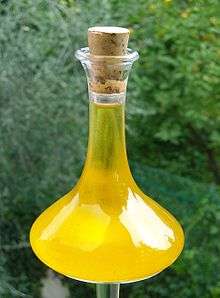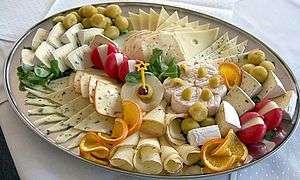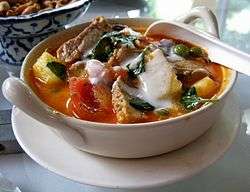Outline of food preparation
The following outline is provided as an overview of and topical guide to food preparation:

Food preparation at the Naval Air Station, Whidbey Island, Washington state
Food preparation – art form and applied science that includes but is not limited to cooking.
What is food preparation?
- Art – an art, one of the arts, is a creative endeavor or discipline.
- Culinary art – art of preparing and cooking foods.
- Skill – learned capacity to carry out pre-determined results often with the minimum outlay of time, energy, or both.
- Meal preparation – the process of planning meals.
Includes types of ingredients needed and the correct preparation of the ingredients for the food item being made.
Essence of food preparation
- Chef – a person who cooks professionally for other people. Although over time the term has come to describe any person who cooks for a living, traditionally it refers to a highly skilled professional who is proficient in all aspects of food preparation.
- Cooking – act of preparing food for eating. It encompasses a vast range of methods, tools and combinations of ingredients to improve the flavour or digestibility of food. It generally requires the selection, measurement and combining of ingredients in an ordered procedure in an effort to achieve the desired result.
- Cuisine – specific set of cooking traditions and practices, often associated with a specific culture. It is often named after the region or place where its underlying culture is present. A cuisine is primarily influenced by the ingredients that are available locally or through trade.
Food preparation techniques
Baking
- Baking – the technique of prolonged cooking of food by dry heat acting by convection, normally in an oven, but can also be done in hot ashes or on hot stones. Appliances like Rotimatic also allow automatic baking.
- Blind-baking – baking pastry before adding a filling.[1]
- Boiling – the rapid vaporization of a liquid, which occurs when a liquid is heated to its boiling point, the temperature at which the vapor pressure of the liquid is equal to the pressure exerted on the liquid by the surrounding environmental pressure.
- Blanching – cooking technique which food substance, usually a vegetable or fruit, is plunged into boiling water, removed after a brief, timed interval, and finally plunged into iced water or placed under cold running water (shocked) to halt the cooking process.
- Braising – combination cooking method using both moist and dry heat; typically the food is first seared at a high temperature and then finished in a covered pot with a variable amount of liquid, resulting in a particular flavour.
- Coddling – food is heated in water kept just below the boiling point.
- Infusion – the process of soaking plant matter, such as fruits or tea leaves, in a liquid, such as water or alcohol, so as to impart flavor into the liquid.
- Pressure cooking – cooking in a sealed vessel that does not permit air or liquids to escape below a preset pressure, which allows the liquid in the pot to rise to a higher temperature before boiling.
- Simmering – foods are cooked in hot liquids kept at or just below the boiling point of water,[2] but higher than poaching temperature.
- Poaching – process of gently simmering food in liquid, generally milk, stock or wine.
- Steaming – boiling water continuously so it vaporizes into steam and carries heat to the food being steamed, thus cooking the food.
- Double steaming – Chinese cooking technique in which food is covered with water and put in a covered ceramic jar and the jar is then steamed for several hours.
- Steeping – saturation of a food (such as an herb) in a liquid solvent to extract a soluble ingredient into the solvent. E.g., a cup of tea is made by steeping tea leaves in a cup of hot water.
- Stewing – food is cooked in liquid and served in the resultant gravy.
- Vacuum flask cooking –
Broiling
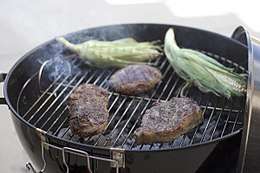
Cooking with charcoal on a barbecue grill
- Grilling – a form of cooking that involves dry heat applied to the surface of food, commonly from above or below.
- Barbecuing – method of cooking meat, poultry and occasionally fish with the heat and hot smoke of a fire, smoking wood, or hot coals of charcoal.
Frying
- Frying – cooking food in oil or another fat, a technique that originated in ancient Egypt around 2500 BC.[3]
- Deep frying – food is submerged in hot oil or fat. This is normally performed with a deep fryer or chip pan.
- Gentle frying —
- Hot salt frying –
- Pan frying – cooking food in a pan using a small amount of cooking oil or fat as a heat transfer agent and to keep the food from sticking.
- Pressure frying –
- Sautéing –
- Shallow frying -
- Stir frying –
Microwaving
- Microwave oven – type of oven that heats foods quickly and efficiently using microwaves. However, unlike conventional ovens, a microwave oven does not brown bread or bake food. This makes microwave ovens unsuitable for cooking certain foods and unable to achieve certain culinary effects. Additional kinds of heat sources can be added into microwave ovens or microwave packaging so as to add these additional effects.
Roasting

Roasting, medieval illuminated manuscript (Tacuina sanitatis casanatensis 14th century)
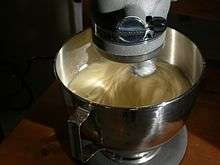
KitchenAid Stand Mixer in action
- Roasting – cooking method that uses dry heat, whether an open flame, oven, or other heat source. Roasting usually causes caramelization or Maillard browning of the surface of the food, which is considered by some as a flavor enhancement.* Grilling – applying dry heat to the surface of food, by cooking it on a grill, a grill pan, or griddle.
- Rotisserie – meat is skewered on a spit - a long solid rod used to hold food while it is being cooked over a fire in a fireplace or over a campfire, or while being roasted in an oven.
- Searing – technique used in grilling, baking, braising, roasting, sautéing, etc., in which the surface of the food (usually meat, poultry or fish) is cooked at high temperature so a caramelized crust forms.
Hot Smoking
Chemical techniques
- Brining –Brining is a process similar to marination in which meat or poultry is soaked in brine before cooking
- Ceviche –
- Drying –
- Fermentation –
- Marinating –
Mechanical techniques
- Basting –
- Cutting
- Dicing –cutting into cubes
- Grating – The use of a grater to mash vegetables.
- Julienning –cutting into very thin pieces such as the thin carrots in store bought salad mix
- Mincing –cutting into very small pieces
- Peeling –to take the outer skin/covering off of a fruit or vegetable
- Shaving –
- chiffonade; cutting in a ribbon like way
- Kneading –
- Milling –
- Mixing ; incorporating different ingredients to make something new; such as how mixing water, sugar, and lemon juice makes lemonade
- Blending ; using a machine called blender to grind ingredients
- Vacuum Filling –
History of food preparation
International cuisine

A sample of some cuisines around the world:
- African cuisine (see list)
- Mediterranean cuisine
- Ethiopian cuisine
- Asian cuisine (see list)
- European cuisine (see list)
- Mediterranean cuisine
- Eastern European cuisine
- English cuisine
- French cuisine
- Italian cuisine
- Oceanian cuisine (see list)
- Cuisine of the Americas (see list)
General ingredients
Decorated bread loaves
- Cereals –
- Cooking fats and oils
- Butter –
- Canola oil –
- Coconut oil –
- Corn oil –
- Rice bran oil –
- Flaxseed oil –
- Lard –
- Margarine –
- Olive oil –
- Palm oil –
- Peanut oil –
- Rapeseed oil –
- Sesame oil –
- Soybean oil –
- Sunflower oil –
- Tallow –
- Dairy –
- Buttermilk –
- Cheese –
- Cream –
- Milk –
- Yogurt –
- Eggs –
- Fruits –
Japanese silken tofu (Kinugoshi Tofu)
- Legumes –

Lamb cutlets
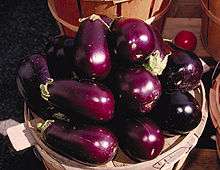
Eggplants, also called Aubergines.
General food preparation concepts
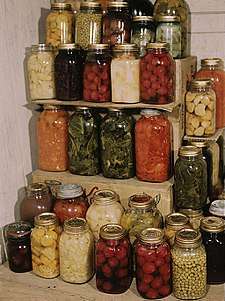
Preserved food
- Cookbook –
- Cooking oil –
- Cooking weights and measures (includes conversions and equivalences common in cooking)
- Cooker or stove –
- Cuisine –
- Cutting board –
- Eating –
- Flavor –
- Food –
- Food and cooking hygiene –
- Foodborne illness –
- Food preservation –
- Ingredients
- International food terms (useful when reading about food and recipes from different countries)
- Maillard reaction –
- Oven –
- Recipe –
- Restaurant –
- Staple food – a food that is "eaten regularly and in such quantities as to constitute the dominant part of the diet and supply a major proportion of energy and nutrient needs".[4]
gollark: What?
gollark: btw i utilize arch linux distribution.
gollark: Initiating orbital `pacman -Syu` strike.
gollark: Anyway, I duckduckwent the issue and apparently it's just a transient issue on Google's end.
gollark: No.
See also
- Cookbooks
- Culinary profession
- Food writing
- Junk food
- List of cocktails
- List of food preparation utensils
- List of soups
- List of twice-baked foods
- Natural food
- Nutrition
- Organic food
- Whole food
References
- "How to blind bake". Tesco realfood. Retrieved 30 December 2011.
- Simmer definition from About.com - Culinary arts. Retrieved May 2009.
- Tannahill, Reay. (1995). Food in History. Three Rivers Press. p. 75
- United Nations Food and Agriculture Organization: Agriculture and Consumer Protection. "Dimensions of Need - Staple foods: What do people eat?". Retrieved 2010-10-15.
External links
| Wikibooks has a book on the topic of: Cookbook |
This article is issued from Wikipedia. The text is licensed under Creative Commons - Attribution - Sharealike. Additional terms may apply for the media files.
